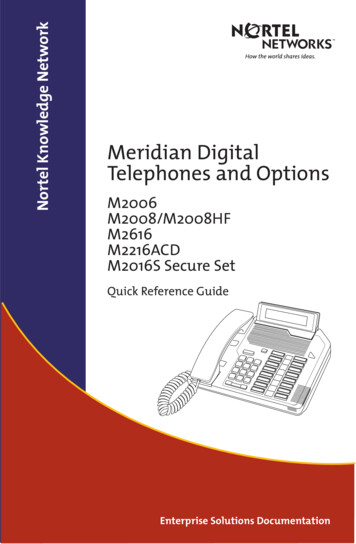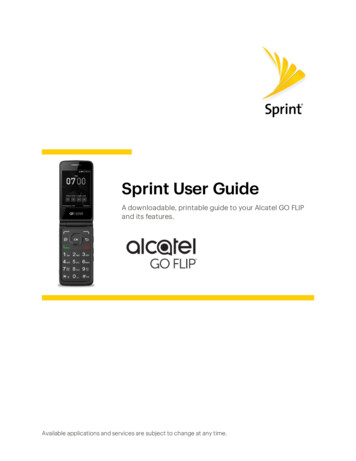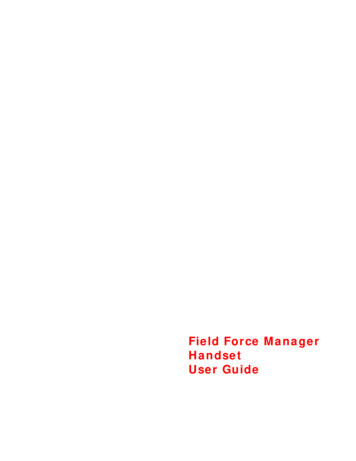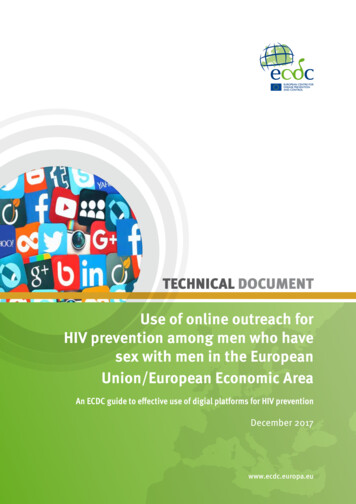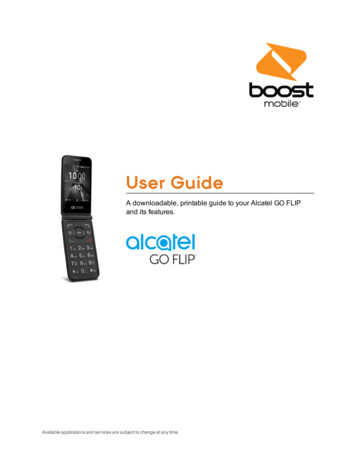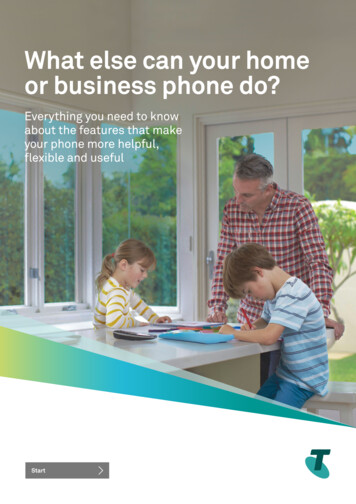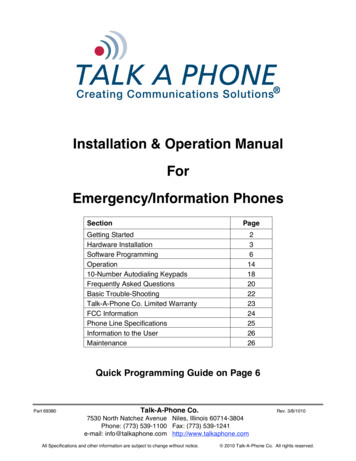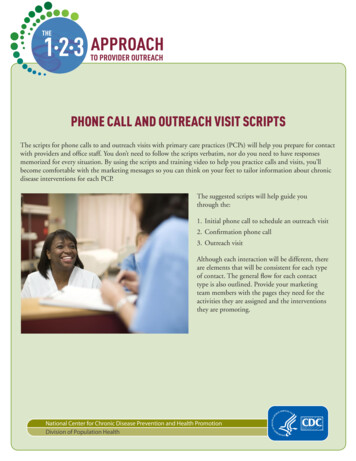
Transcription
Journal of Community Health (2022) 44-6ORIGINAL PAPERAn Outreach Phone Call Project: Using Home Health to Reach IsolatedCommunity Dwelling Adults During the COVID 19 LockdownSarah Miner1 · Lora Masci2 · Chris Chimenti3· Nary Rin3 · Adrianne Mann3 · Brigid Noonan4Accepted: 23 October 2021 / Published online: 9 November 2021 The Author(s), under exclusive licence to Springer Science Business Media, LLC, part of Springer Nature 2021AbstractHome health care (HHC) focuses on delivering skilled health care services to patients in their homes. Over 82% of HHCpatients are 65 and older, and living with chronic health conditions. In an effort to respond to the risk the COVID-19 pandemicpresented for patients, a HHC agency designed “The Outreach Phone Call Project”. This program was developed to providetelephone support to at-risk patients who had received HHC prior to the COVID-19 lockdown. In total, 16 Care TransitionManagers participated in the project and over 4,000 patients received a call from the clinical team. Approximately 44% ofthe calls did not require any further follow up, 20% of the patients did not answer the call, and 3% of patients were referredback to HHC. Another 13% needed education and assistance with social issues. The calls provided a means of safe connection and support between providers and patients during the pandemic and facilitated access to health and social resources.However, the most beneficial aspect of the program was the opportunity for seasoned HHC nurses to identify clinical changesin the health of patients and to assist them in the triage process. Results of this study demonstrate that the implementationof a calling project during the pandemic shutdown provided invaluable connection and outreach to vulnerable populations.This simple change in practice enabled HHC professionals to reach patients who were isolated and in need of education andassistance. As a result of the implementation of an “Outreach Phone Call Project”, the HHC agency learned many lessonswhich may be helpful to others who would like to create a similar program in the future. It facilitated clinical assessment,education and intervention for isolated patients during the COVID 19 pandemic and implementation of similar practiceshould be considered in the post-pandemic world.Keywords Home care · COVID-19 · Chronic health problems · Tele-health care · Social and health services determinantsof health1Wegmans School of Nursing, St. John Fisher College, 3690East Avenue, Rochester, NY 14618, USASarah Minersminer@sjfc.edu2Graham Plastic Surgery, 6536 Anthony Drive, Suite C,Victor, NY 14564, USALora Mascilora.masci@gmail.com3HCR Home Care, 85 Metro Park, Rochester, NY 14623,USANary Rinnrin@hcrhealth.com4School of Nursing and Health Professions, TrinityWashington University, 125 Michigan Avenue, Washington,DC 20017, USA* Chris Chimenticchimenti@hcrhealth.comAdrianne Mannamann@hcrhealth.comBrigid Noonannoonanb@trinitydc.edu13Vol:.(1234567890)
Journal of Community Health (2022) 47:266–272IntroductionHome health focuses on delivering skilled health care services to patients in their homes. There are over 12,000certified home health agencies in the US that care for over3.4 million patients [1]. In order to qualify for home careservice patients must be under the care of a physician,possess a need for skilled care, and be considered homebound [2]. Over 82% of home health patients are aged 65and older, and the large majority of home health patientsaccess these services because they are living with chronichealth conditions. According to the Centers for DiseaseControl (CDC) a staggering 89% of home health patientshave a diagnosis of high blood pressure, 45% have diabetes, 32% have COPD and 24% have asthma [3]. Thisdoes not account for the number of patients who may beliving with more than one of these conditions at the sametime. What this profile demonstrates is not only that homehealth services are aimed at caring for some of our mostvulnerable patients, but that this population is also amongthose at highest risk for contracting Coronavirus Disease(COVID 19) and the negative outcomes associated withthis diagnosis.The COVID-19 pandemic arrived in the US earlySpring of 2020. The US and upstate New York confrontedthis new, frightening reality and the consequences of virustransmission, as well as the measures taken to battle theensuing situation in healthcare. On Sunday, March 22,2020 Governor Cuomo announced the "New York Stateon PAUSE" executive order [4]. Aspects of this 10-pointplan included the closing of all non-essential businessesand cancellation of all non-essential gatherings. Individuals with illnesses were instructed not to leave theirhomes to receive medical care unless deemed absolutelynecessary and as a result, many patients did not attendregularly scheduled health care appointments [5]. Nearlyall health systems were halted and forced to reevaluatehow to deliver health care services in a way that was safefor patients and providers. Priority of resources and services were directed to the pandemic, and other health caredelivery systems were forced to close or postpone services. Many people, for reasons of fear and/or safety, wereencouraged or chose to stop seeking healthcare servicesat this time because of the pandemic and the healthcareresponse to it [6]. Across the board, health care visitsdeclined, and primary care visits specifically declinedbetween 21% and 35% compared to 2018 and 2019.Given their experience with high risk and fragilepatient populations, home health providers understoodthat this widespread reporting of medical care avoidancewould likely put vulnerable individuals’ safety and healthat risk. In particular, providers recognized that many of267the vulnerable populations they served had little accessto technology, and many people’s health needs would beleft untreated, resulting in potentially irreversible declinesin health. In an effort to respond to this risk, the agencydesigned an outreach program dedicated to checking inon previous home health patients based on a very simplepremise: giving them a phone call. The Outreach PhoneCall Project was developed to provide outreach support toat-risk patient populations who had received home careservices prior to the COVID-19 lockdown. The purpose ofthis article is to describe the Outreach Phone Call Projectimplemented by a home care agency in the Spring of 2020.Project DesignUnlike many other health care systems, home healthcare didnot shut down during the pandemic. HCR Home Care is ahome care agency based in New York State and serves 25Upstate counties. During the time period of the program, theagency employed 16 hospital-based Care Transition Managers across the state. Care Transition Managers (CTMs) areclinical referral specialists who work as liaisons in the hospital setting to assist patients and hospital discharge planningteams to deliver a seamless transition from the hospital tohome after an inpatient stay. During the pandemic, hospitalswere closed to all outside visitors and liaisons. However,CTMs continued to work remotely to assist patients in theirtransition from discharge to the home environment.When fewer patients presented to hospitals and avoidedseeking medical care, it became clear to the CTMs thatpatient needs were likely left untreated and potentially irreversible declines in health could result over time. The homehealth agency understood their patients were not only athigh risk because of COVID, but also because of the manyunderlying chronic health issues that often requiring regularhealth care visits and attention that could not be accessedduring the shutdown. This was worrisome not only for thepatients they currently served, but for previous patients whono longer had home health services and were left more isolated and at risk because of the ongoing pandemic.Using an electronic medical record (EMR) admissionsreport, the agency identified who among their previouspatients would be most at risk for negative health and socialoutcomes as a result of the COVID shut down. CTMs wereassigned a list of patients to call, and when possible, theCTM was assigned patients who were known to them fromtheir previous home health episode. The purpose of the callswas to connect with the person, determine if they requiredhelp, and align them with needed resources when applicable.Calls were conducted in English or Spanish depending uponthe native language.13
Journal of Community Health (2022) 47:266–272Table 2 Outcomes of PhoneCall Outreach (n 4,057)269Outcomesn %No Answer/No VoicemailDeclined assistance (No current health/social needs)Declined assistance due to COVID (Did not want anyone visiting home duringpandemic)Moved out of service areaMoved to assisted living or long term careNew Referral to Home healthActive Patient (already receiving home care services)Future Referral (Possible need for home care services in the future)Referral for social needs/services and/or other servicesExpiredTotal nts from 8 other language groups. Because of the waythat data was initially captured for the project, tracking ofrace and ethnicity status were not consistently done, andmost of the patient in the database were categorized as beingof “Unknown” race or ethnicity (n 3,604). However, in thecases where this information was collected, n 84 of thepeople who received calls were defined as being of Hispanicbackground, n 26 as Black or African American, n 2 asAsian, and n 33 as white.Table 2 describes the outcomes of the phone calls placedby the CTMs. Approximately 44% of the calls did not requireany further follow up because the patients and families didnot have any additional needs at the time of the call and20% of the patients could not be reached or did not answerthe call. The CTM’s did refer n 126 (3%) patients backto homecare because of new clinical needs discovered during the phone call, and another n 85 (2%) were classifiedas possibly needing home care in the future. This includedpatients who described upcoming surgeries or procedures,patients who the CTMs had to send to the ER as a result ofimmediate clinical needs discovered during the phone call.A total of n 542 (13%) patients did not require clinicalservices at the time of the call, but did need assistance withother services. This included referrals to food pantries, assistance with transportation and other social needs.In addition to the data collected in the database, theCTMs who participated in the project described outcomesrelated to the experience of making the phone calls and talking with families. The lack of patient interaction caused bythe COVID pandemic was a struggle for the CTMs. Theynicknamed the project “Positive Patient Calls.” They feltthat participating in making the phone calls improved theirpersonal and professional satisfaction by facilitating interaction and connection with patients and families. The calls alsoserved as a means of safe connection between the providersand patients during the pandemic. They used the opportunity to facilitate access to resources such as food, cleaningsupplies or clothing. They also used the calls to supportpatients and caregivers who were overwhelmed and struggling with loneliness, fear and isolation.The CTMs also quickly recognized that the phone callswere an invaluable opportunity for patient education. Manypatients and their caregivers were afraid and confused aboutthe rapidly changing information associated with COVID 19,how and when to access health care during the pandemic,and struggled with technology and the concept of telehealth.CTMs used the phone calls as an opportunity to help patientsunderstand the most up to date regulations and recommendations for COVID prevention and precautions. They couldalso help patients understand which health care serviceswere re-opening, and when and how telehealth could beused as an alternative form of connecting with healthcareproviders.However, the most beneficial aspect of the OutreachPhone Call Project was the opportunity for seasoned homecare nurses to identify clinical changes in the health ofpatients and to assist them in the triage process when necessary and appropriate. The call team described a numberof instances where they were able to support patients whorequired medical assistance. CTMs could talk to familiesand patients to determine what the best plan of care wouldbe for them, taking into account the COVID 19 pandemicand its effect on healthcare delivery. Help could be offered topatients and families to determine if they needed to visit primary care, if telehealth would be an option for them, and insome instances if returning to home care services would beappropriate. For example, as the regulations for homeboundstatus were relaxed and mid-level providers were allowed tosign home care orders, CTMs could more easily help generate new referrals to homecare when needed and appropriate. All of the calls were made to patients who had beendischarged from home care services. However, by the timethe phone calls were made, there were 271 patients who hadalready been referred back to home care for assistance. In a13
270few cases, CTMs also described a need for emergency clinical intervention, requiring them to call 911 for the patientsand their families. Having seasoned home care professionalsavailable to help with this triage during the pandemic solidified the importance of conducting an outreach program suchas the one completed in this agency. Their ability to connectthe patients and their families to the most appropriate andneeded service was essential to promoting safety and wellbeing in the midst of a life-altering pandemic.DiscussionResults of this study demonstrate that the implementationof a calling project during the pandemic shutdown providedinvaluable connection and outreach to vulnerable populations. This simple but effective change in practice enabledhome care professionals to reach patients who were bothisolated and often in need of education and assistance. Whilethe pandemic did require people to stay home and isolate forsafety, this response also led to other negative health effectsrelated to isolation, and the inability to access needed healthand social resources.By June 30, 2020, despite the incorporation of telehealthvisits by many healthcare providers,an estimated 41% ofU.S. adults had delayed or avoided medical care becauseof concerns about COVID-19 [5]. Avoidance of urgent oremergency care was more prevalent among unpaid caregivers for adults and persons with underlying medical conditions and disabilities. These are the populations that homecare agencies serve, and this is why they were those targetedby this phone outreach program. The CTMs who startedthis program understood this, and knew the shutdown wouldincrease the vulnerability of their patients. Table 1 highlightsthe large and diverse numbers of primary health conditionsin the study population, as well as the diverse languagesspoken by these patients and their families. In summary, thepeople reached by this call program were those most at riskfor negative health outcomes as a result of COVID 19 andmost in need of additional support to maintain their safety.Telehealth is an exciting tool and certainly will continue tobe utilized in the future as a viable alternative to face to facemeetings. However, it is important to consider that not all populations have access to the technology required for telehealth,or would be able to understand it without having someoneteach it to them first. [7, 8]. The home care agency implementing this program has more than 10 years of experience usingtelehealth with their patient population. They were familiarwith the unique needs patients and families have when firsttrying to understand and use the technology. It is because ofthis that the team deliberately started this program using phonecalls tbeused as an alternative form of connecting with healthcareproviders.However, the most beneficial aspect of the OutreachPhone Call Project was the opportunity for seasoned homecare nurses to identify clinical changes in the health ofpatients and to assist them in the triage process when necessary and appropriate. The call team described a numberof instances where they were able to support patients whorequired medical assistance. CTMs could talk to familiesand patients to determine what the best plan of care wouldbe for them, taking into account the COVID 19 pandemicand its effect on healthcare delivery. Help could be offered topatients and families to determine if they needed to visit primary care, if telehealth would be an option for them, and insome instances if returning to home care services would beappropriate. For example, as the regulations for homeboundstatus were relaxed and mid-level providers were allowed tosign home care orders, CTMs could more easily help generate new referrals to homecare when needed and appropriate. All of the calls were made to patients who had beendischarged from home care services. However, by the timethe phone calls were made, there were 271 patients who hadalready been referred back to home care for assistance. In a13
270few cases, CTMs also described a need for emergency clinical intervention, requiring them to call 911 for the patientsand their families. Having seasoned home care professionalsavailable to help with this triage during the pandemic solidified the importance of conducting an outreach program suchas the one completed in this agency. Their ability to connectthe patients and their families to the most appropriate andneeded service was essential to promoting safety and wellbeing in the midst of a life-altering pandemic.DiscussionResults of this study demonstrate that the implementationof a calling project during the pandemic shutdown providedinvaluable connection and outreach to vulnerable populations. This simple but effective change in practice enabledhome care professionals to reach patients who were bothisolated and often in need of education and assistance. Whilethe pandemic did require people to stay home and isolate forsafety, this response also led to other negative health effectsrelated to isolation, and the inability to access needed healthand social resources.By June 30, 2020, despite the incorporation of telehealthvisits by many healthcare providers,an estimated 41% ofU.S. adults had delayed or avoided medical care becauseof concerns about COVID-19 [5]. Avoidance of urgent oremergency care was more prevalent among unpaid caregivers for adults and persons with underlying medical conditions and disabilities. These are the populations that homecare agencies serve, and this is why they were those targetedby this phone outreach program. The CTMs who startedthis program understood this, and knew the shutdown wouldincrease the vulnerability of their patients. Table 1 highlightsthe large and diverse numbers of primary health conditionsin the study population, as well as the diverse languagesspoken by these patients and their families. In summary, thepeople reached by this call program were those most at riskfor negative health outcomes as a result of COVID 19 andmost in need of additional support to maintain their safety.Telehealth is an exciting tool and certainly will continue tobe utilized in the future as a viable alternative to face to facemeetings. However, it is important to consider that not all populations have access to the technology required for telehealth,or would be able to understand it without having someoneteach it to them first. [7, 8]. The home care agency implementing this program has more than 10 years of experience usingtelehealth with their patient population. They were familiarwith the unique needs patients and families have when firsttrying to understand and use the technology. It is because ofthis that the team deliberately started this program using phonecalls to reach out to families and patients. A simple outreachphone call became an invaluable tool in reaching vulnerable13Journal of Community Health (2022) 47:266–272populations and assuring their access and understanding ofoptions in a dynamic and quickly changing clinical landscape.Home care professionals have long-standing relationships with their patients. Their connection and relationshipwith these patients meant they already had a baseline understanding of the conditions these patients were facing, andmost importantly, they already had their trust. They werenot strangers calling these patients and families for the firsttime. They were building on previously established relationships, which is why home care was such a vital asset duringthis time. Knowing these patients and families facilitated theability of the CTMs to reconnect with and help them accessthe services they needed in order to remain safe at home.As a result of the implementation of this program, theagency learned a number of lessons which were helpful inimproving the process, and may be helpful to others whowould like to create a similar program in the future. Thesecould prove beneficial to other organizations that may wishto implement similar strategies or programs.Collecting and Defining Call OutcomesThe program started with the simple idea of making a phonecall to check in on vulnerable patients. In order to do this,the group initially used the home care agency electronicmedical record (EMR) to capture the needed information, and then each CTM transferred relevant informationto spreadsheets where they could enter data on the phonecalls. However, it became clear that the free hand entering of information related to the contents of the call andthe outcome was neither efficient nor able to truly captureall the work and content being covered in the calls. It alsomade program evaluation more challenging. A more usefulapproach would be to develop and establish a tool for datacollection prior to initiating phone calls that would promotemore thorough and consistent data collection. Using theinformation from the initial calls, the CTMs began to consolidate the most common responses to their calls as well asthe most common needs of patients. This information wasalso used to set up interpretive guidelines for CTMs as wellas common resources and referral information to facilitatethe process of providing information during the call, as wellas tracking the outcomes. Moving forward, the CTMs wouldsuggest starting out with a tool that could be easily filled outin a common database that provided guidelines and referralinformation for the CTMs.Developing a Focused Call StrategyFor the initial call algorithm, the CTMs focused on patientswho had been recently discharged from home health. Theydid this because they believed that recently discharged
Journal of Community Health (2022) 47:266–272patients might be dealing with health issues that would makethem particularly vulnerable during the COVID pandemicand health care shutdown. This approach was useful, but alsohighlighted that the EMR could be used to identify otherpopulations that could be vulnerable. For example, the EMRcontained information on patients who had been identifiedas high risk for re-hospitalization during their home careepisode or having a high social risk profile. It would alsobe useful to continue to evaluate the timing of the phonecalls being made to the patients, and how far out from homehealthcare discharge the call should be made. For example,some of the patients and families did not have immediateneeds, but did develop health and social needs 2–3 monthsafter leaving home healthcare services. Future phone callprograms could use this information to help identify vulnerable populations and to focus the type of education andresource referral that would be needed for them.Developing a Strong Resource Referral Poolto Respond to Social Determinants of HealthOne thing that was clear from the call program is that manyof the challenges faced by the patients were not alwaysdirectly related to home health services, or even medicalissues for that matter. Perhaps one of the most importantindicators of the needs of the patients in this study was thatn 542 required assistance with predominantly social issuesrelated to the Social Determinants of Health. This numberis most likely an underestimate, as being categorized in thissection required that the patients and families self-identifiedthis need, and also did not account for those who may havebeen categorized in other outcomes, but also had socialneeds.During the COVID-19 pause, the Social Determinantsof Health were more apparent as traditional access andresources available to vulnerable population were adverselyimpacted [9]. CTMs described patients as needing assistancewith food, clothing, transportation and rent. The team members had to be able to make referrals outside of traditionalhome care services and having a resource list ready, as wellas being familiar with available services in the community,was essential. This helped to ensure that even if home carewas not the solution, the calling team members could provide connections to resources.In order to do this, the team worked directly with theHealth Home Care Management team. Health Homes are aNYS funded Medicaid Program designed to help bridge thegaps within our healthcare system [10]. Health Home agencies are designed to identify and support patients who are“at risk” of re-hospitalization by responding to their socialneeds. Patients who qualify for Medicaid can further qualifyfor Health Homes services based on having a medical and/271or behavioral health diagnosis. This program responds to theSocial Determinants of Health by connecting patients withresources such transportation, affordable safe housing, foodsecurity, and access to primary care providers. Collaborating with this resource was essential to supporting patientsduring the COVID 19 pandemic. Moving forward, outreachprograms would be best served by collaborating with HealthHomes programs in order to respond holistically to the needsof patients and families.Continued Evaluation of NeedsIn addition to the patients who were referred to home careas a result of the phone call, Table 2 highlights that n 1803patients reached by phone declined services either becausethey did not feel they needed them or did not want anyonecoming into their home. However, additional analysis andchart review demonstrated that n 419 of these patients didreturn to home care services in the following months afterreceiving the phone call. Additionally, as mentioned, n 542had significant social needs that needed to be addressed.This suggests that the phone call outreach program providesan important opportunity for identifying both current andfuture needs. This project and its results are based on onephone call to the patients by the CTM. Further follow-up andadditional phone calls may have been beneficial, and shouldbe considered when designing future phone call outreachprograms.ConclusionThe impact of the delays in care or care avoidance during theCOVID-19 pause are still being explored. Many organizations found themselves examining and creating new pathways for patients to access services. In many ways home carecan be viewed as a preferred alternative to other types ofcare during this time period to include sub-acute rehab outpatient rehab. However, the traditional pathways for patientsto access home care services were disrupted so significantlythat many organizations explored alternative pathways.As studies on the effects of the pandemic will be exploredfor years, this study emphasizes the impact of isolation invulnerable populations. The implementation of a phonecall outreach program was a relatively simple intervention.However, the potential impact is far reaching. It not onlyfacilitated clinical assessment and intervention in at riskpopulations, it was able to deliver patient education andperhaps most importantly- connection for vulnerable andemotionally isolated patients and families. Knowing thatmany community-dwelling senior citizens experience socialisolation and fail to routinely connect with their medical13
272provider, a long-standing phone calling program aimed atreaching the highest-risk patients is something to considerin the post-pandemic world.Author’ Contributions Not applicable.Funding Funding for this research provided by a grant from HCRCares, a non-for-profit organization (https:// hcrhe alth. com/ hcr- cares).Data Availability The dataset generated and analyzed for this study arenot publicly available due to need to protect patient privacy. However,the de-identified dataset can be made available from the correspondingauthor on reasonable request.Code Availability Not applicable.DeclarationsConflict of interest Not applicable.Ethical Approval January 6, 2021File No: 4142-12172020-01Dr. Sarah MinerSt. John Fisher CollegeDear Dr. Miner:Thank you for submitting your research proposal to the InstitutionalReview Board.I am pleased to inform you that the Board has approved your ExemptReview project, “Responding to vulnerable population during COVID19: A home health phone call protocol”.Please note, to reduce the spread of COVID-19 and to help mitigatecommunity transmission, St. John Fisher College has temporarily suspended all in-person activities (recruitment and data collection) amongresearchers and study participants for all IRB-approved human subjectsresearch until further notice. Studies that do not involve any direct subject contact, e.g., pre-existing records, electronic surveys, tele-research,and remote interaction via device/app/software are still permissible,along with data analysis from previously collected in-person sessions.Should you have any questions about this process or your responsibilities, please contact me at irb@sjfc.edu.Sincerely,Eileen Lynd-Balta, Ph.DChair, Institutional
1 Wegmans School of Nursing, St. John Fisher College, 3690 East Avenue, Rochester, NY 14618, USA Graham Plastic Surgery, 6536 Anthony Drive, Suite C, Victor, NY 14564, USA HCR Home Care, 85 Metro Park, Rochester, NY 14623, USA 4 School of Nursing and Health Professions, Trinity Washington University, 125 Michigan Avenue, Washington,
